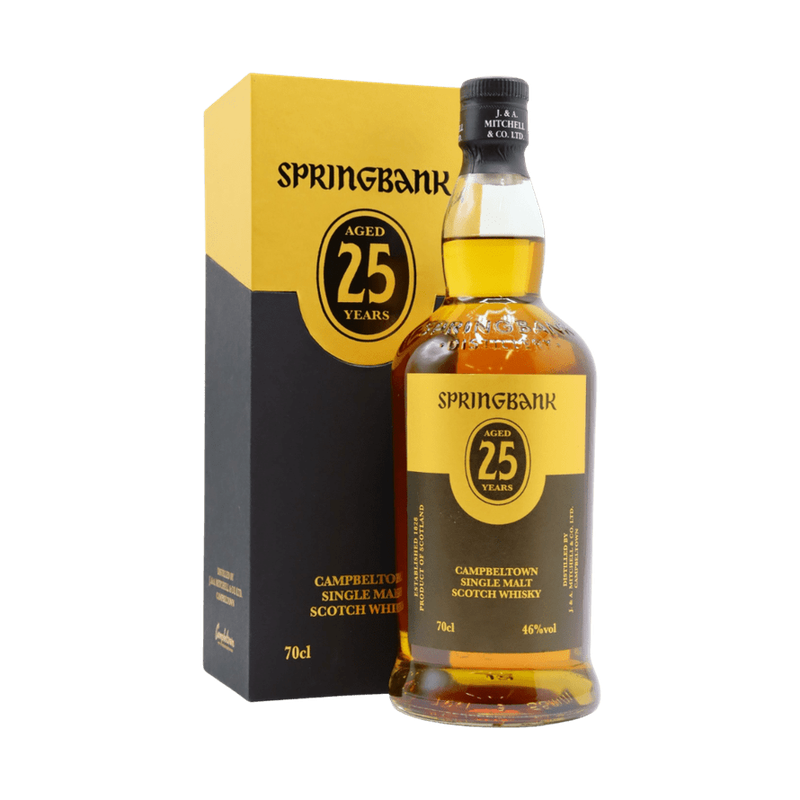
Springbank Distillery
Scotland's oldest independent family-owned distillery, founded in 1828
Overview
Springbank is the only distillery where the entire process is conducted on site from floor malting to bottling. Several distilleries, such as Balvenie, have floor malting operations, but all the malted barley used at Springbank is 100% produced on site.
Springbank distillery is producing three different types of single malt whiskies: Springbank, a medium peated whisky produced using a partial triple-distillation, sometimes named as 2.5 distillation, Longrow, a heavily peated whisky double-distilled, and Hazelburn since 1997, a lightly peated and triple-distilled whisky. Longrow was first produced in 1973-4, then for a short period in 1987 and finally since 1989, it is produced every year. The distillery is still owned by the original family.
History
The Reid family, in-laws of the Mitchells, established Springbank distillery in 1828 on the previous illicit site of Archibald Mitchell, although no reference in Excise returned. Until 1837, the distillery was registered under the name of William Reed Jun. & Co, who sold it to John & William Mitchell. The distillery operated between 1852-60 under the name J.W. Mitchell & Co, before it was changed in 1867 to J. & W. Mitchell & Co. In 1878, the name was recorded under J. A. Mitchell (John Mitchell and his son Alexander), when William left.
In 1881, the distillery became a limited company as J. A. Mitchell & Co until 1891, when it got dissolved and reconstructed as Alexander Mitchell. It was then incorporated as J. & A. Mitchell & Co in 1897, who are still the owners. The distillery was closed during the WWI and WWII, in 1926-35, in 1980 and most of the time between 1981 to 1989. In 1992, Springbank decided to restore the floor malting. Springbank acquired most of the buildings of the adjacent Longrow distillery, with one Longrow warehouse used as a warehouse and a second warehouse used as a bottling plant. The Springbank cark park is the proper location of the Longrow distillery.
Source: The distilleries of Campbeltown by David Stirk, The Making of Scotch whisky by John R. Hume & Michael S. Moss and The Scotch Whisky Distilleries by Misako Udo.
Patrick Brossard © December 2007
Scotland's oldest independent family-owned distillery, founded in 1828
Overview
Springbank is the only distillery where the entire process is conducted on site from floor malting to bottling. Several distilleries, such as Balvenie, have floor malting operations, but all the malted barley used at Springbank is 100% produced on site.
Springbank distillery is producing three different types of single malt whiskies: Springbank, a medium peated whisky produced using a partial triple-distillation, sometimes named as 2.5 distillation, Longrow, a heavily peated whisky double-distilled, and Hazelburn since 1997, a lightly peated and triple-distilled whisky. Longrow was first produced in 1973-4, then for a short period in 1987 and finally since 1989, it is produced every year. The distillery is still owned by the original family.
History
The Reid family, in-laws of the Mitchells, established Springbank distillery in 1828 on the previous illicit site of Archibald Mitchell, although no reference in Excise returned. Until 1837, the distillery was registered under the name of William Reed Jun. & Co, who sold it to John & William Mitchell. The distillery operated between 1852-60 under the name J.W. Mitchell & Co, before it was changed in 1867 to J. & W. Mitchell & Co. In 1878, the name was recorded under J. A. Mitchell (John Mitchell and his son Alexander), when William left.
In 1881, the distillery became a limited company as J. A. Mitchell & Co until 1891, when it got dissolved and reconstructed as Alexander Mitchell. It was then incorporated as J. & A. Mitchell & Co in 1897, who are still the owners. The distillery was closed during the WWI and WWII, in 1926-35, in 1980 and most of the time between 1981 to 1989. In 1992, Springbank decided to restore the floor malting. Springbank acquired most of the buildings of the adjacent Longrow distillery, with one Longrow warehouse used as a warehouse and a second warehouse used as a bottling plant. The Springbank cark park is the proper location of the Longrow distillery.
Source: The distilleries of Campbeltown by David Stirk, The Making of Scotch whisky by John R. Hume & Michael S. Moss and The Scotch Whisky Distilleries by Misako Udo.
Patrick Brossard © December 2007
Adelphi Selection 'Springbank' 21 Year Old 1999 Single Malt Scotch Whisky
Springbank 21 Year Old Campbeltown Single Malt Scotch Whisky
Springbank Palo Cortado Cask Matured 10 Year Old Single Malt Scotch Whisky
Springbank 12 Year Old Cask Strength Single Malt Scotch Whisky
Springbank Private Cask Owner's Private Bottling Single Malt Scotch Whisky
Springbank 30 Year Old Campbeltown Single Malt Scotch Whisky
Springbank 10 Year Old Local Barley 2011 Campbeltown Single Malt Scotch Whisky
Springbank 10 Year Old Campbeltown Sherry Wood Pedro Ximénez Cask Matured Single Malt Scotch Whisky
Cadenhead 11 Year Old 'Original Collection - Springbank' Single Malt Scotch Whisky
Springbank Amontillado Cask Matured 10 Year Old Single Malt Scotch Whisky
Springbank 12 Year Old Cask Strength Campbeltown Single Malt Scotch Whisky
Springbank 11 Year Old Local Barley 2011 Campbeltown Single Malt Scotch Whisky
Springbank 15 Year Old Campbeltown Single Malt Whisky (750mL)
Springbank 10 Year Old Campbeltown Single Malt Scotch Whisky
Springbank 13 Year Old Local Barley Campbeltown Single Malt Scotch Whisky
Springbank 18 Year Old Campbeltown Single Malt Scotch Whisky
Springbank 25 Year Old 2022 Edition Campbeltown Single Malt Scotch Whiskey
Springbank 25 Year Old 2023 Edition Campbeltown Single Malt Scotch Whiskey
Springbank 17 Year Old Madeira Cask Matured Single Malt Scotch Whisky
- Featured
- Best selling
- Alphabetically, A-Z
- Alphabetically, Z-A
- Price, low to high
- Price, high to low
- Date, old to new
- Date, new to old






















